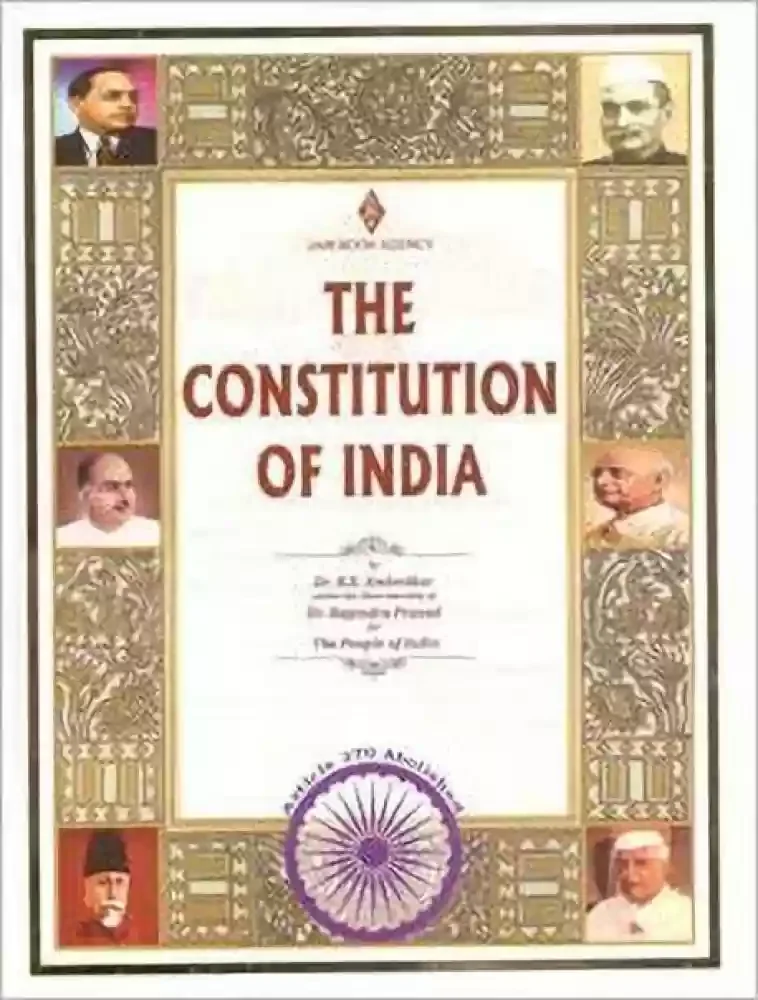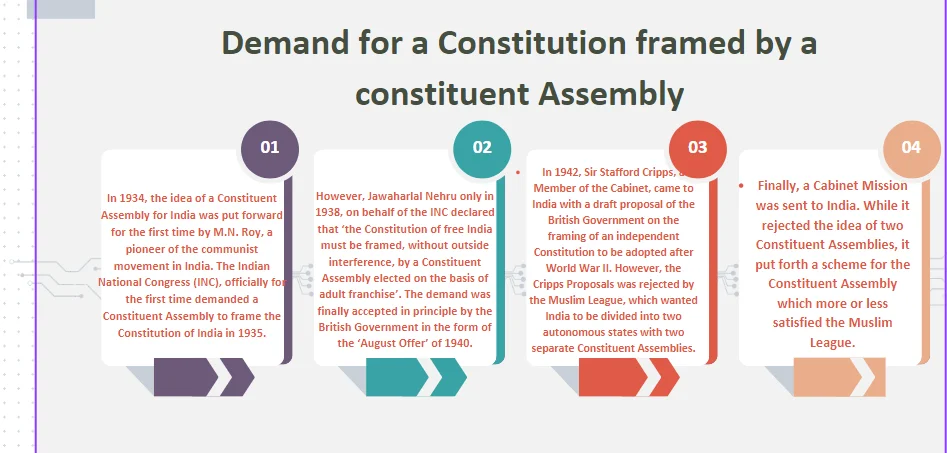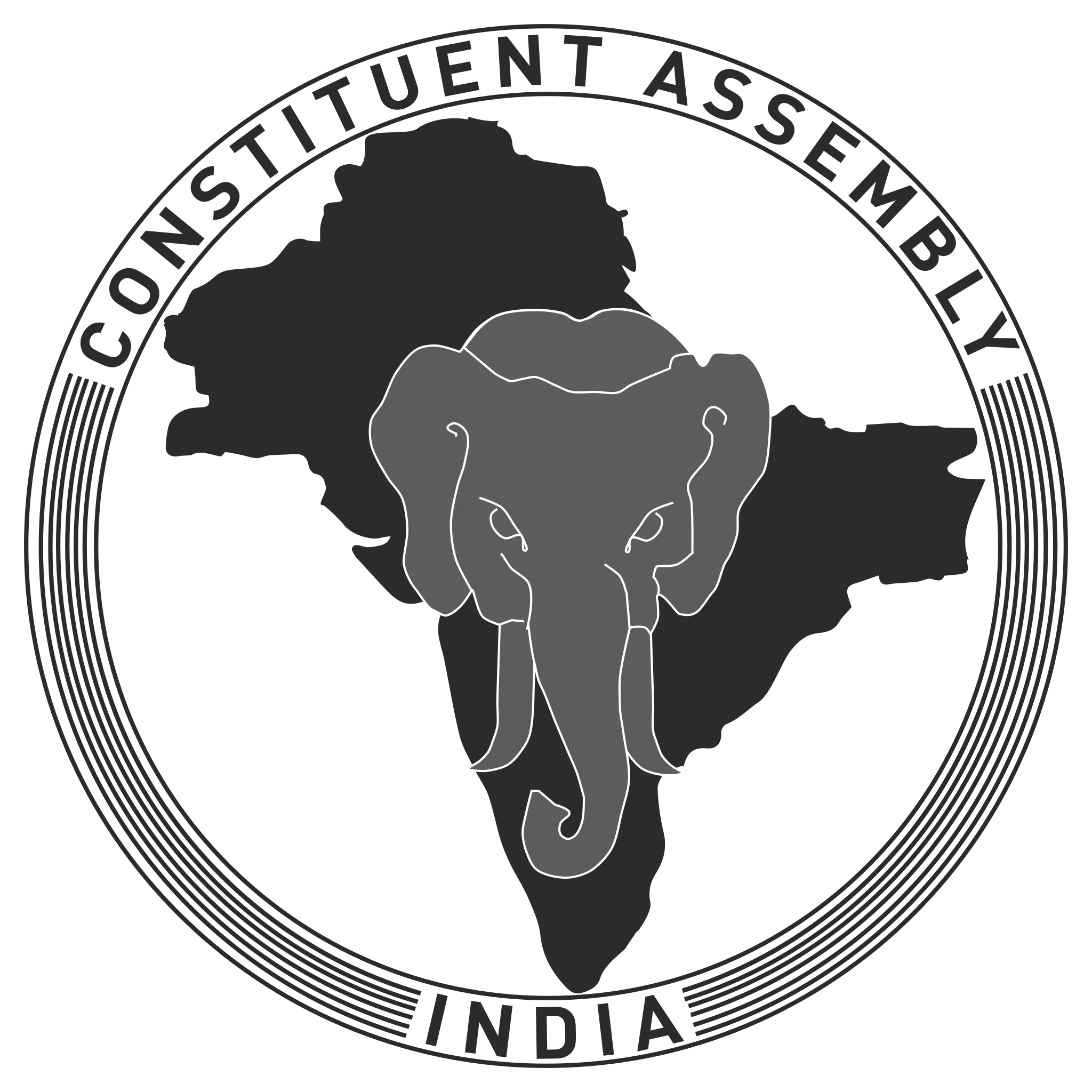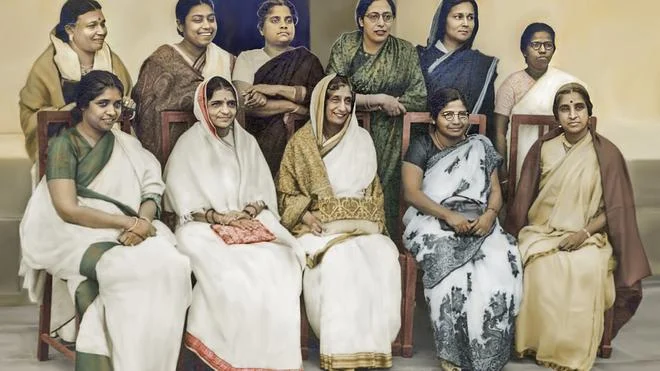The idea of a Constituent Assembly for India was first proposed by M.N. Roy in 1934 and later supported by Jawaharlal Nehru. By 1946, the Cabinet Mission Plan laid out the framework for its formation, marking a significant step toward India’s independence. This Assembly was crucial in drafting the Constitution of the newly independent nation.
The Emergence of the Constituent Assembly Idea and Its Historical Context
MN Roy’s Proposal for a Constituent Assembly (1934): MN Roy for the first time put forward the idea of a constituent assembly for India in 1934.

- Jawaharlal Nehru’s Declaration (1938): In 1938 JL Nehru declared that “the Constitution of free India must be framed, without outside interference by a Constituent Assembly elected on the basis of the adult franchise”.
- Reiteration at Ludhiana Session (1939): This was reiterated in 1939 at the Ludhiana Session of the All India States People’s Conference under the leadership of Nehru.
- British Government’s Resistance and World War II Impact: This demand was, however, resisted by the British Government until the outbreak of World War II when external circumstances forced them to realize the urgency of solving the Indian Constitutional problem.
“Swaraj will not be a free gift of the British Parliament; it will be a declaration of India’s full-expression. That it will be expressed through an Act of Parliament is true but it will be merely a courteous ratification of the declared wish of the people of India even as it was in the case of the Union of South Africa.”–Gandhiji
Enroll now for UPSC Online Course

Constituent Assembly
Cabinet Mission Plan on the composition of Constituent Assembly: The formation of the Constituent Assembly took place in November 1946, following the structure outlined in the Cabinet Mission Plan. The key provisions of the Cabinet Mission Plan included:

- Representation Strength: The Constituent Assembly’s total strength was set at 389 members.
- Out of these, 296 seats were designated for British India, and 93 seats were allocated to the princely states.
- Within the 296 seats for British India, 292 members were to be chosen from the eleven governors’ provinces and four from the Chief Commissioners’ provinces, with one member from each.
- Proportional Representation: Provinces and princely states (or groups of states in the case of smaller states) were to receive seats based on their respective populations.
- Roughly one seat was to be allotted for every million people.
- Communal Representation: Seats assigned to British provinces were to be distributed among the three principal communities—Muslims, Sikhs, and General (all except Muslims and Sikhs)—in proportion to their population.
- Representatives of each community were to be elected by members of that community in the provincial legislative assembly, utilizing proportional representation through the single transferable vote method.
- Nomination in the Princely States: Representatives from the princely states were to be nominated by the heads of those states.
In summary, the Constituent Assembly was designed to be a body that was partly elected and partly nominated. Furthermore, its members were to be indirectly elected by members of the provincial assemblies, who themselves were elected under a limited franchise.
Outcome of the Elections in 1946
Results of the 1946 Constituent Assembly Elections: Elections for the Constituent Assembly were held in July-August 1946, resulting in the Indian National Congress securing 208 seats, the Muslim League claiming 73, and the remaining 15 seats distributed among small groups and independents.
- Vacant Seats for Princely States: Nevertheless, the 93 seats designated for princely states remained vacant as these states chose not to participate in the Constituent Assembly.
- Representation of Indian Society: Despite not being directly elected by the Indian people through the adult franchise, the Constituent Assembly was representative of various segments of Indian society, encompassing Hindus, Muslims, Sikhs, Parsis, Anglo-Indians, Indian Christians, SCs, STs, and women from these communities.
- Prominent Figures in the Constituent Assembly: The Assembly featured prominent figures from India’s diverse landscape, excluding Mahatma Gandhi.
Impacts of the Indian Independence Act of 1947 on the Constituent Assembly
Joining of Princely State Representatives: The representatives of the princely states, who had stayed away from the Constituent Assembly, gradually joined it. On April 28, 1947, representatives of the six states were part of the Assembly.
- Impact of the Mountbatten Plan: After the acceptance of the Mountbatten Plan of June 3, 1947, for the country’s partition, the representatives of most of the other princely states took their seats in the Assembly.
- The members of the Muslim League from the Indian Dominion also entered the Assembly.
- Changes Due to the Indian Independence Act of 1947: The Indian Independence Act of 1947 made the following three changes in the position of the Assembly:
- Sovereignty of the Assembly: The Assembly was made a fully sovereign body, which now could frame any Constitution as it required.
- The act empowered the Assembly to abrogate or alter any law made by the British Parliament in relation to India.
- Dual Functions of the Assembly: The Assembly also became a legislative body. Two separate functions were assigned to the Assembly, that is, making of the Constitution for free India and enacting ordinary laws for the country.
- These two tasks were to be performed on separate days.
- Role as the First Parliament of Free India: Thus, the Assembly became the first Parliament of free India (Dominion Legislature).
- Whenever the Assembly met as the Constituent body, it was chaired by Dr. Rajendra Prasad, and when it met as the legislative body, it was chaired by G.V. Mavlankar.
- Sovereignty of the Assembly: The Assembly was made a fully sovereign body, which now could frame any Constitution as it required.
- Reduction in the Strength of the Constituent Assembly: However, due to the withdrawal of Muslim league members, the total strength of the Assembly came down to 299, as against 389 originally fixed in 1946 under the Cabinet Mission Plan.
- The strength of the Indian provinces (formerly British Provinces) was reduced from 296 to 229 and those of the princely states from 93 to 70.
The newly formed Constituent Assembly
First Meeting of the Constituent Assembly: The Constituent Assembly’s first meeting was held on December 9, 1946. But the Muslim League boycotted the meeting and insisted on a separate state of Pakistan. Hence, it was attended by only 211 members.
- Election of Temporary President: According to French practice, Dr. Sachchidananda Sinha, the oldest member, was elected as the temporary President of the Assembly. However, later Dr. Rajendra Prasad was elected as the President of the Assembly.
- Election of President and Vice-Presidents: Similarly, both H.C. Mukherjee and V.T. Krishnamachari were elected as the Vice-Presidents of the Assembly. (The Assembly had two Vice-Presidents)
Women Members of the Constituent Assembly

- On January 24, 1950, when the representatives of the people who had participated in drafting the Indian Constitution signed the document, it’s noteworthy that among the signatories were 11 women.
- It is crucial to highlight their names, bringing attention to these women who often get overlooked in discussions dominated by the term “founding fathers.”
- The list includes
- G. Durgabai
- Ammu Swaminathan
- Amrit Kaur
- Dakshayani Velayudhan
- Hansa Mehta, Renuka Ray
- Sucheta Kripalani
- Purnima Banerji
- Begum Qudsiya Aizaz Rasul
- Kamala Chaudhri
- Annie Mascarene
Enroll now for UPSC Online Course
- Initially, the Constituent Assembly had 15 women members, and two more were elected later. In 1946, Hansa Mehta expressed satisfaction that women made up approximately 5% of the total Constituent Assembly membership, a significant achievement for women given the competitive nature of securing seats in a body that made decisions through voting.
| Must Read | |
| Current Affairs | Editorial Analysis |
| Upsc Notes | Upsc Blogs |
| NCERT Notes | Free Main Answer Writing |
Conclusion
The Constituent Assembly, formed in November 1946, was a landmark development in India’s path to independence. It was designed to be a representative body with members elected and nominated based on the Cabinet Mission Plan’s guidelines, setting the stage for the creation of a democratic India.
Sign up for the PWOnlyIAS Online Course by Physics Wallah and start your journey to IAS success today!
| Related Articles | |
| Mountbatten Plan | Muslim League |
| Mahatma Gandhi Biography, Birth, Early Life, Education, Death | Constituent Assembly of India |

 GS Foundation
GS Foundation Optional Course
Optional Course Combo Courses
Combo Courses Degree Program
Degree Program









